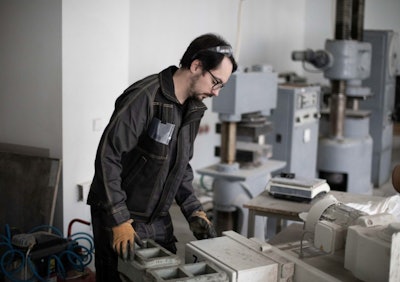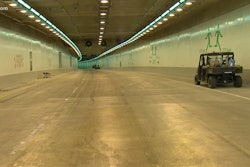 Vytautas Bocullo, researcher at KTU Faculty of Civil Engineering and Architecture.
Vytautas Bocullo, researcher at KTU Faculty of Civil Engineering and Architecture.Scientists at the Kaunas University of Technology (KTU) in Lithuania are developing ways to produce concrete using industrial waste instead of cement, thereby reducing the amount of carbon dioxide released into the atmosphere during the production of cement. According to a report by the university, it is as strong as traditional concrete, but is more resilient when it comes to the damaging effects of acid, and more stable when exposed to extreme heat and cold.
“At first, the idea that concrete can be produced without using cement seemed radical,” said Vytautas Bocullo, researcher at KTU Faculty of Civil Engineering and Architecture, according to the university. “Now, after several years of intensive work, we succeeded to develop alkali-activated concrete, which compressive strength is 55 MPa (the same as in usual concrete). Instead of Portland cement, we are using alkali activated industrial waste products — fly ash, biofuel bottom ash, AlF3 production waste — silicagel etc.”
Bocullo says the biggest advantage of this type of binder is that it uses a large amount of industrial waste, containing an active form of silicon and aluminium compounds. He says he believes any material containing silicon and aluminium compounds could be used, including blast furnace slag or metakaolin, material derived from modification of clay mineral kaolitine.
The materials are treated with a special alkaline solution, which makes them begin to melt and bind like traditional cement. The final product can be either geopolymer or alkali-activated material, depending on what materials are used. Alkali-activated concrete is much more resilient to the effects of fire and acid and, due to its higher pH, it protects the concrete armature against corrosion.
Bocullo says the alkali-activated concrete can be used instead of traditional concrete in many fields, but recommends using local materials to make it more cost efficient to produce.
“We are trying to use waste materials from local industry, such as aluminium fluoride production waste — silica gel and biofuel ash,” Bucolla adds, according to the university. “The preparation of the substance depends on the material itself. For example, fly ash of coal can be used instantly, but the biofuel ash needs to be grinded up to the fineness of the cement. In order to improve the qualities of the final product, several substances can be mixed, but before that, their chemical composition and additives need to be investigated for their impact on the environment and on the compressive strength of the concrete.”









